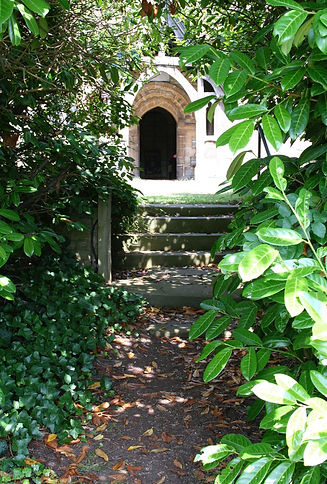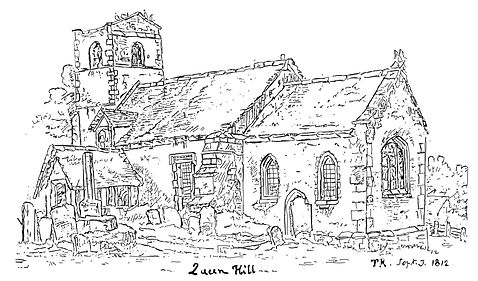
The history...

Earliest Days:
There has been a place for Christian worship at Queenhill for centuries, and the earliest building is thought to have been a circular wooden edifice.
The Saxons built first on the present site but all that remains is a fragment of an inverted round-arched light inserted into the Nave wall. All other traces internally were eradicated by Norman rebuilding.
Before the Conquest, the Manor of Queenhill was an outlying Manor of Ripple, ie a parcel of land comprising all or part of a Parish held by an individual, usually a Lord, with part let to his tenants. The Manor of Ripple was then held by Ailrick, brother of the Bishop of Worcester.
In the Domesday Survey (1086), the name of the parish of Queenhill wasspelt 'Cumhille'; a name given to it by the Saxons, meaning 'a small vale or dingle in the side of a hill'. 'Cumhille' was then in the hands of the King William I, it having been forfeit by Ralph de Bernay, a
despoiler of land and supporter of Earl William of Hereford (1020-1071).
In the 13th Century, William de Kardiff tenanted the manor which was held by the Crown, on condition of presenting one hound to the King annually on the feast of St Michael, an arrangement that continued until about 1629, but then lapsed.
In 1349, the Manor was valued at only 40 shillings because of the Black Death, and it descended through the female line to the Oldcastles. The Head of the family was Sir John Oldcastle, who was condemned as a heretic but escaped from the Tower of London to lead a rebellion against King Henry V after which he was executed. He sought refuge near the Malvern Hills and it is believed he sheltered at Queenhill. Moreover, when Shakespeare's Henry IV premiered on stage (1597-98), the character Sir John Falstaff was called Sir John Oldcastle but the name was eventually changed, probably for political reasons.
The Manors then passed to the Gowers of Woodhall, and was later bought by Nicholas, Lord Lechmere, who sold it to William Dowdeswell in 1852.
Queenhill remained a Chapel in the car of the Rector of Ripple until 1880 when it became the Parish Church of Queenhill with *Holdfast.
*There was once a Chapel at Holdfast, on one wall of which was a mural of a young king riding on a red lion, but the Antiquarian Habington (1560-1647) - who was involved in the Gunpowder Plot - reported it as so ruined that 'he hardly durst look into it'.
The Chapel was sited close by Holdfast Hall, but all trace of it has long since gone; and there was no right of burial, so the dead were interred at Queenhill.
After the Civil War (1642-1651)
Local Gentry:
The Dowdeswell family owned Pull Court [now Bredon School] between 1628 until 1934. They also owned much property in the surrounding villages, and were responsible for the restoration of Queenhill Church and the complete rebuilding of nearby Bushley Church during the 19th Century.
Nine members of the family sat in Parliament between 1660 and 1875, and the following extracts from 'The Nation in the Parish, or Records of Upton on Severn' byRobert Lawson, published in 1884, gives an insight into the activities of the local Gentry during the period immediately after the Glorious English Revolution which ended the reign of James II in 1688.
'To those who remembered that awful period of national strife [the Civil War], there was something marvellous in the ease with which the kingdom changed its rulers in the Great Revolution. Yet it brought disunion among neighbours and suffering for conscience sake...'

'A published letter of Mr Richard Dowdeswell gives some account of an [intelligence- gathering] expedition, undertaken in the summer of 1690 by the order of Lord Shrewsbury, the object of which was to gauge political opinions by requiring certain laymen and clergy to take the oath of allegiance.
Mr Thomas Bromley [then owner of Ham Court, close to Queenhill] accompanied the expedition as commander of a troop of horse. In contrast to Bromley's religious views, the creed of both James II and his Queen and the profligate tone of [post Restoration] society were hateful. Although in his sixty-second year and in bad health, he girded on sword and pistols, and rode from manor to parsonage, and from town to village, to assist in checking an expected Jacobite rising. Some gentlemen, who accompanied their refusal with violent and disrespectful remarks about William and Mary, were committed to various prisons...'

It is a matter of record that'the proportion of laity who were avowed Jacobites in Worcestershire was even smaller than that of clergy; among them Mr Gower of Queenhill, High Sheriff for the year 1690. He was deprived of his office on refusing to take the oaths, and suffered severely in the matter of fines. His brother, Mr George Gower, continued to reside at his house on the edge of the Heath, until his death from smallpox in 1695. The remainder of the gentry around Upton belonged, so far as is known, to the anti-Jacobite faction.
A Conflicted Clergyman:
'Mr Woodforde [Rector of Upton, d.1663] was a Royalist and a sound Churchman; there are several indications of his care as to festival days and we may be sure that he was strict in observing the rules and ritesof the Church. He was not, however, one of the extreme party;...he had the power of yielding in non-essential points; as is evident from the fact that he was allowed to retain his office between three and four years longer than some thousands of the clergy of England, and only left when required to sign the Covenant...A remarkable number of well-to-do families formed part of Mr Woodforde'scongregation. Walking across the causeway fields, along the ancient roadway, came Mr Bromley [Ham Court] with his fair and noble wife, and their troop of little children; a shorter walk brought Mr Hill to church from his pleasant home at Greenfields, with his wife, a cousin of the Bromleys. Mr and Mrs Lygon were residing either at the Heath or the Hill and some of the Gowers were inhabiting Heath End. They were descended from a family that had owned estates in Worcestershire for several centuries, and among them Queenhill...'